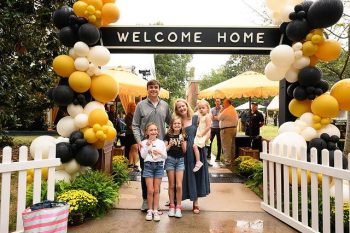Yesterday was a day for notable events. “You could be celebrating the start of the Civil War” or David Letterman’s birthday, Harold W. Tribble Professor of Art Margaret Supplee Smith told those of us who squeezed into 102-C of the Scales Fine Arts Center at 5:30 p.m.
Perhaps.
Those occasions have their followers, but yesterday we gathered at Scales to celebrate Dr. Smith, better known as Peggy Smith. We had come to hear what was dubbed her farewell lecture on what turned out to be her birthday (don’t ask her age; you wouldn’t believe it if I told you. She’s ageless). It also marked the anniversary of the lecture she gave 32 years ago for her job interview at Wake Forest.
Am I ever glad she got the job! Peggy (I didn’t dare call her that then) was one of the finest teachers I had at Wake Forest, a true role model for me and a good number of my friends. I carried my pocket-size “American Architecture” guide from one of her classes for years and was inspired in part by her passion for art to collect paintings myself. I remember studying the slide of the Sagrada Familia in Barcelona, Spain, and wondering why my art history professors made such a big deal of a bizarre, unfinished monstrosity church by a wacky dreamer named Antoni Gaudi. Then, nine years after graduation, I found myself standing in front of the church in awe of the unfinished, magnificent masterpiece. It had not come to life in a slide box in Scales but in the words of professors such as Peggy and the late Bob Knott. I remembered my Wake Forest art history professors in gratitude on that day of awe in Barcelona. They had been right all along.
Peggy surely felt the admiration of students, colleagues and old friends at her lecture called “Architecture Matters: past, current and future research, including American ski resorts.” Architecture, she said, “is the one art form that everybody encounters in everyday life.” We who view it bring our sentiments to it. “Wake Forest is a good example. Ask students why did they come here,” she said. They usually say it’s because it looks like what they think a college campus looks like.
Her lecture was a personal journey. She showed “some buildings that have mattered to me.” With characteristic wry humor she said, “Don’t worry. It’s not year by year.” She began with a photo of Friends Select School in Philadelphia; a 5-year-old Peggy sits on what appears to be a jungle gym teeming with children. That was her school, and its location meant that in Peggy’s early life she was surrounded by great buildings: Philadelphia City Hall in its Second Empire-style splendor, Wanamaker’s Department Store designed by Daniel Burnham, the Pennsylvania Academy of Fine Arts designed by Frank Furness and George Hewitt. Every school day she rode with her mother from their home in New Jersey across the Benjamin Franklin Bridge into central Philadelphia. “To a child … buildings fed my memories, gave me a sense of place and influenced my awareness of cultural values,” she said. All those buildings she encountered “influenced my sense of the public realm.”
She showed us the Chapel of the Holy Innocents, next door to the Episcopal boarding school she attended in New Jersey at ages six and seven. She would grow up to learn that the chapel was a significant example of Gothic Revival architecture. She allowed us to hop aboard in memory the six-week ride she took with her grandmother from the East Coast to California, “traveling exactly as the builders intended” — by train — to grand hotels like Old Faithful Inn at Yellowstone to movie stars’ homes in Beverly Hills. A decidedly inspirational moment came in 1957 when she was on a family trip to Jamestown and Williamsburg, Va. She loved the scenes and decided she would grow up to become “a costumed guide” at Williamsburg.
Years later, in the 1970s, she would be featured in a Glamour magazine article as someone “with a Brown Ph.D” fresh in hand who had abandoned her dream of becoming a costumed guide for a new goal: to be on Williamsburg’s board of directors. Peggy’s thesis involved tracing the history of 3,500 row houses in Boston’s South End at a time American cities were trying to reclaim their sense of place. “I learned that architecture could tell stories and connect people with their history,” she said. She joined Wake Forest in 1979, teaching art and architectural history. She served four terms as department chair and helped establish the University’s Women’s Studies Program.
“I am just retiring from teaching,” Peggy told us. “I’m not dying.”
She has more research lined up and a book on the way about the history of American ski resorts. “But I have satisfaction,” she said, clicking the computer to show a slide replete with gravestones, “that only an architectural historian can — of knowing that my family burial place is in America’s second Picturesque Rural Cemetery,” designed by the same architect who designed the little Gothic Revival chapel, where as a first-grader she carried the crucifix up the aisle at Sunday Vespers.
The circle comes round. The first lecture and the last lecture, both delivered on an April day.
Enjoy retirement, Peggy. You will be missed in the classrooms of Scales but remembered by students everywhere who look up during their architectural encounters in everyday life and savor the delight of seeing a building that gives life meaning or sparks a memory. I’m one of those students. Peggy taught me.



